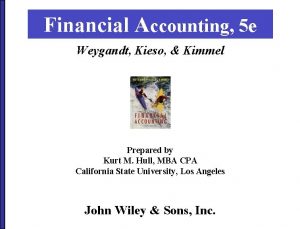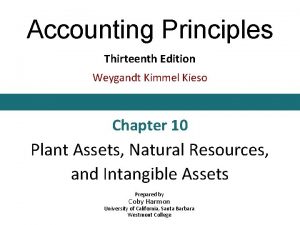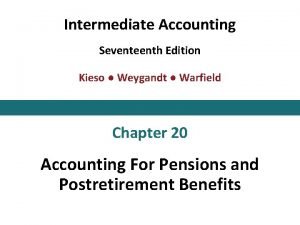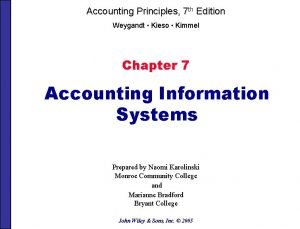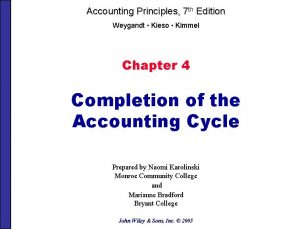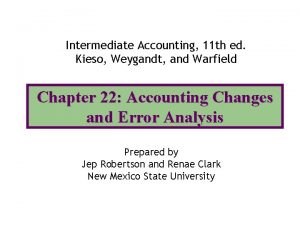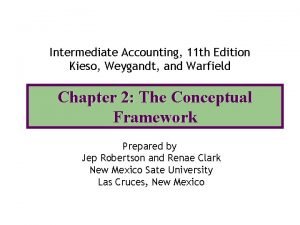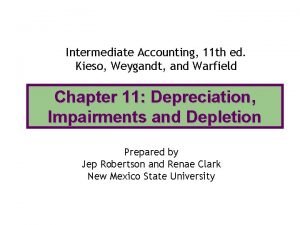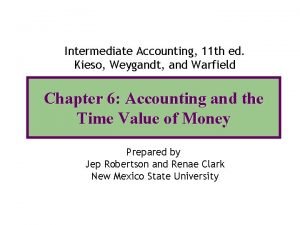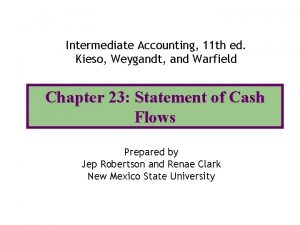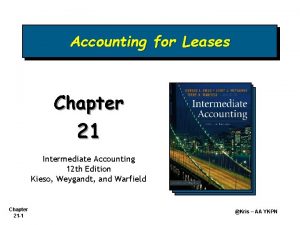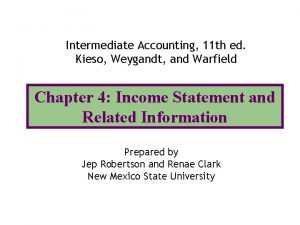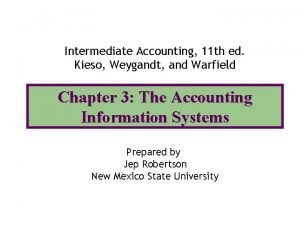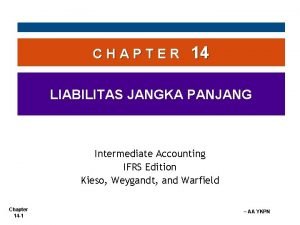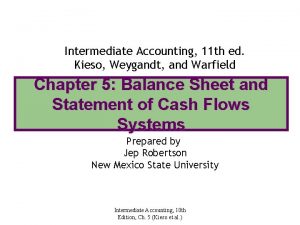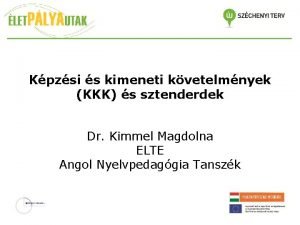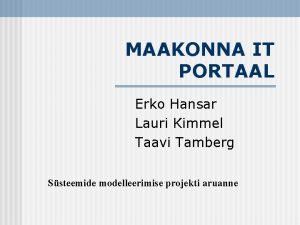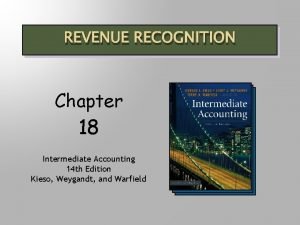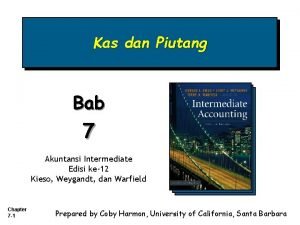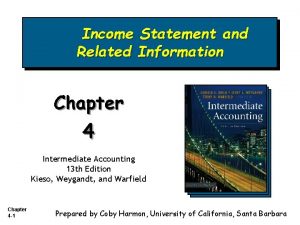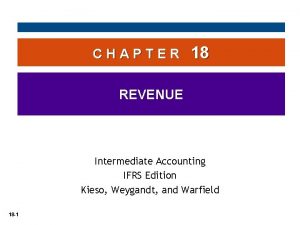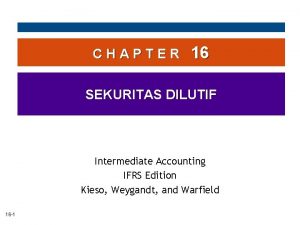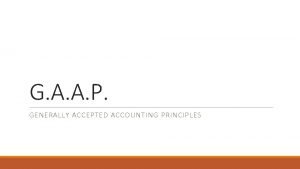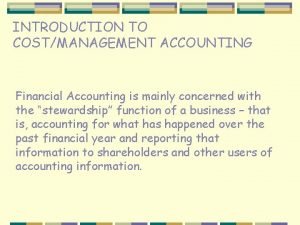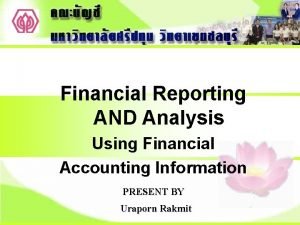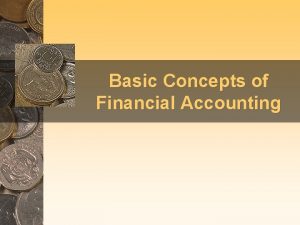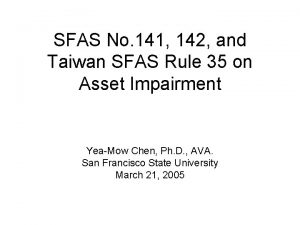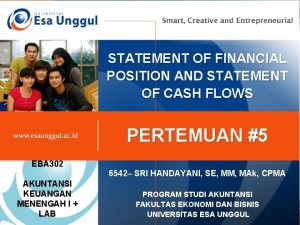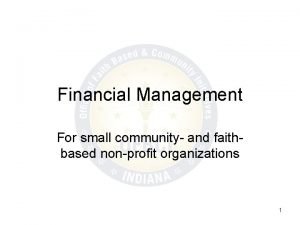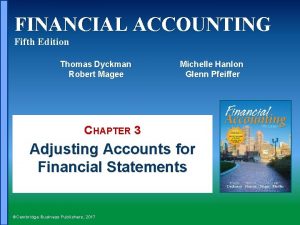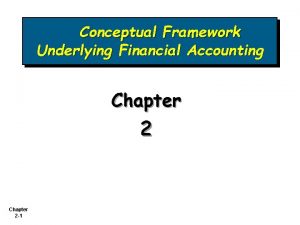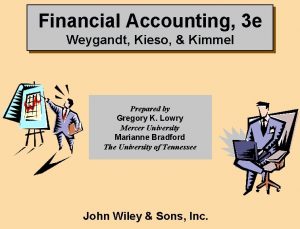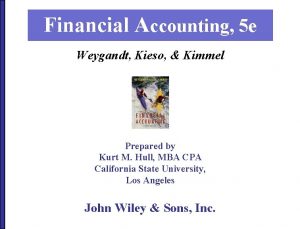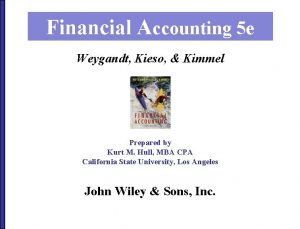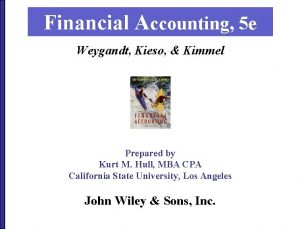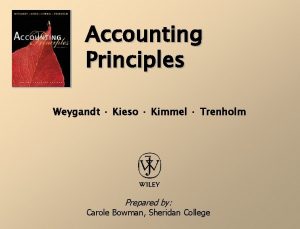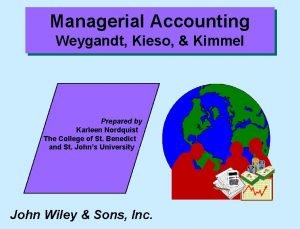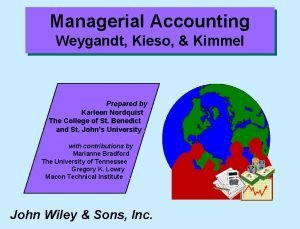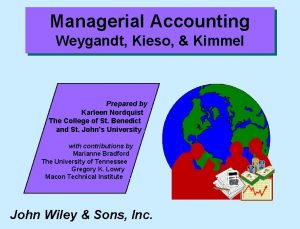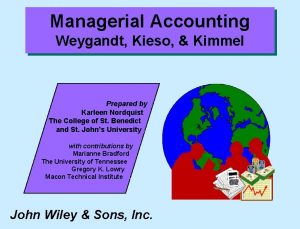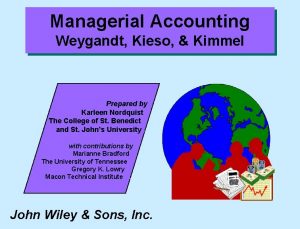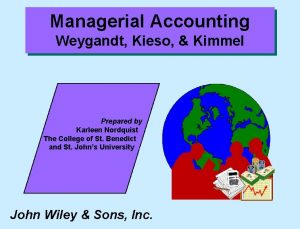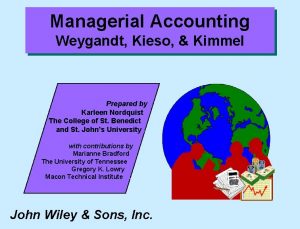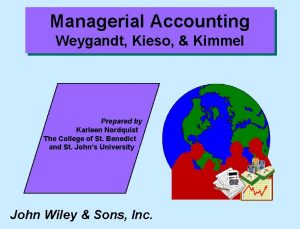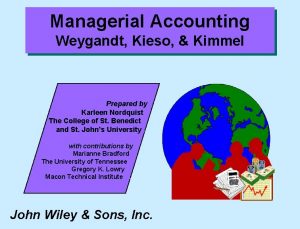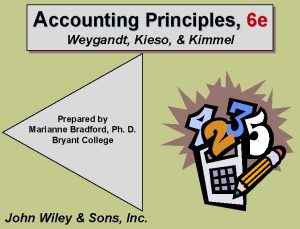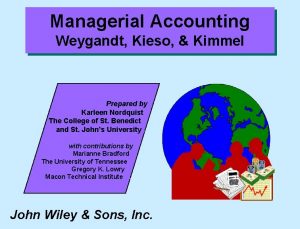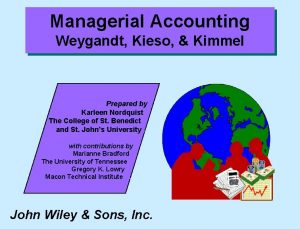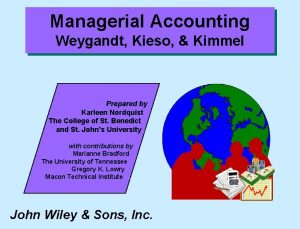Financial Accounting 5 e Weygandt Kieso Kimmel Prepared














































- Slides: 46

Financial Accounting, 5 e Weygandt, Kieso, & Kimmel Prepared by Kurt M. Hull, MBA CPA California State University, Los Angeles John Wiley & Sons, Inc.

CHAPTER 2 THE RECORDING PROCESS STUDY OBJECTIVES After studying this chapter, you should understand: Accounts Ledgers Debits and credits Posting The recording process Journals Trial balance

STUDY OBJECTIVE 1 THE ACCOUNT l. An account is an individual record of increases and decreases in a specific asset, liability, or owner’s equity item. l. Commonly referred to as “T-Accounts. ” Title of Account Left or debit side Right or credit side Debit balance Credit balance

STUDY OBJECTIVE 2 DEBITS AND CREDITS l Debit means left l Credit means right l When the debit amounts exceed the credits, an account has a debit balance; when the reverse is true, the account has a credit balance. DR CR

DOUBLE-ENTRY SYSTEM l In a double-entry system, equal debits and credits are made in the accounts for each transaction. l Thus, the accounting equation will always stay in balance. Assets Liabilities Equity

DEBIT & CREDIT EFFECTS ON ASSETS & LIABILITIES Debits Increase assets Decrease liabilities Credits Decrease assets Increase liabilities

REVIEW QUESTION DEBIT & CREDIT EFFECTS ON ASSETS & LIABILITIES Which accounts below are decreased by debits? • Inventory • Accounts Payable • Dividends • Cash • Notes payable Answer: Accounts payable and Notes payable Why? Both are liabilities, which are increased by credits and decreased by debits.

NORMAL BALANCE OF ASSET & LIABILITY ACCOUNTS Assets Increase Debit Decrease Credit Normal Balance Liabilities Decrease Debit Increase Credit Normal Balance

DEBIT & CREDIT EFFECTS ON STOCKHOLDERS’ EQUITY COMMON STOCK/RETAINED EARNINGS Debits Decrease equity Credits Increase equity

NORMAL BALANCE OF STOCKHOLDERS EQUITY COMMON STOCK/RETAINED EARNINGS Decrease Debit Increase Credit Normal Balance

DEBIT & CREDIT EFFECTS ON DIVIDENDS Increase Debit Normal Balance Decrease Credit

DEBIT & CREDIT EFFECTS ON REVENUES Debits Decrease revenues Increase expenses Credits Increase revenues Decrease expenses

NORMAL BALANCES OF REVENUES & EXPENSES Revenues Decrease Debit Increase Credit Normal Balance Expenses Increase Debit Normal Balance Decrease Credit

EXPANDED ACCOUNTING EQUATION Assets Dr. + Cr. - = Liabilities Dr. - Stockholders’ Equity + + Cr. + Common Stock Dr. - + Dr. + Cr. + Revenues Dr. - - Cr. + Dividends - Cr. - Expenses Dr. + Cr. -

STUDY OBJECTIVE 3 THE RECORDING PROCESS Illustration 2 -13 JOURNAL LEDGER 1. Analyze each transaction 2. Enter transactions in a journal 3. Transfer journal information to the ledgers

STUDY OBJECTIVE 4 JOURNALS l Transactions are initially recorded in chronological order in a journal before being transferred to the accounts. l The journal records the complete effect of each transactions, making errors easy to locate(記錄每筆交易對特定科目之借 貸影響和交易重要內容) l Every company has a general journal which contains 1. 2. 3. 4. Transaction dates Account titles References Two amount columns

SIMPLE JOURNAL ENTRY If an entry involves only two accounts, one debit and one credit, it is considered a simple entry. GENERAL JOURNAL Date 2006 July 1 Account Titles and Explanation Cash K. Browne, Capital (Invested cash in the business) Ref. Debit J 1 Credit 20, 000

COMPOUND JOURNAL ENTRY When three or more accounts are required in one journal entry, the entry is referred to as a compound entry. GENERAL JOURNAL Date 2006 July 1 1 2 3 Account Titles and Explanation Delivery Equipment Cash Accounts Payable (Purchased truck for cash with balance on account) Ref. J 1 Debit Credit 14, 000 8, 000 6, 000

STUDY OBJECTIVE 5 THE LEDGER • The general ledger contains all the assets, liabilities, and stockholders’ equity accounts for a given company Illustration 2 -16 Individual Assets Equipment Land Supplies Cash Individual Liabilities Interest Payable Salaries Payable Accounts Payable Notes Payable Individual Stockholders’ Equity Salaries Payable Fees Earned Common Stock Retained Earnings

STUDY OBJECTIVE 6 POSTING Posting is the process of transferring entries from the journals to specific accounts in the General Ledger J 1 GENERAL JOURNAL Date 2006 July 1 Account Titles and Explanation Cash Common Stock (Invested cash in the business) Ref. Debit Credit 20, 000 GENERAL LEDGER

POSTING A JOURNAL ENTRY J 1 GENERAL JOURNAL In. Date the ledger, Account enter in the and appropriate Titles Explanation columns of the account(s) debited 2006 the date, Sept. 1 journal Cash page, and debit amount shown in the Stock journal. Common Ref. 10 25 Debit Credit 15, 000 (invested cash in business) GENERAL LEDGER CASH Date 2006 Sept. 1 Explanation NO. 10 Ref. J 1 Debit Credit 15, 000 COMMON STOCK Date 2006 Sept. 1 Explanation Balance NO. 25 Ref. J 1 Debit Credit Balance 15, 000 Transaction information is transferred to the individual ledger accounts affected.

CHART OF ACCOUNTS Most companies have a chart of accounts that lists the accounts and the account numbers which identify their location in the ledger.

INVESTMENT OF CASH BY STOCKHOLDERS Transaction Basic Analysis Debit-Credit Analysis October 1, C. R. Byrd invests $10, 000 cash in exchange for ownership interest in Pioneer Advertising Agency, Inc. The asset Cash is increased $10, 000, and Common Stock is increased $10, 000. Debits increase assets: debit Cash $10, 000. Credits increase stockholders’ equity: credit Common Stock, $10, 000.

INVESTMENT OF CASH BY STOCKHOLDERS JOURNAL ENTRY Date Oct. 1 Account Titles and Explanation Cash Common Stock (Issued shares of stock for cash ) Ref. 101 311 Debit 10, 000 Credit 10, 000 POSTING Cash Oct. 1 10, 000 Common Stock Oct. 1 311 10, 000

PURCHASE OF OFFICE EQUIPMENT Transaction Basic Analysis Debit-Credit Analysis October 1, office equipment costing $5, 000 is purchased by signing a 3 -month, 12%, $5, 000 note payable. The asset Office Equipment is increased $5, 000, and the liability Notes Payable is increased $5, 000. Debits increase assets: debit Office Equipment $5, 000. Credits increase liabilities: credit Notes Payable $5, 000.

PURCHASE OF OFFICE EQUIPMENT JOURNAL ENTRY Date Oct. 1 Account Titles and Explanation Office Equipment Notes Payable (Issued 3 -month, 12% note for office equipment) Ref. 157 200 Debit 5, 000 Credit 5, 000 POSTING Office Equipment Oct. 1 5, 000 157 Notes Payable Oct. 1 200 5, 000

RECEIPT OF CASH FOR FUTURE SERVICES Transaction October 2, a $1, 200 cash advance is received from R. Knox, a client, for advertising services that are expected to be completed by December 31. Basic Analysis The asset Cash is increased $1, 200; the liability Unearned Fees is increased $1, 200 because the service has not been rendered yet. Note that although many liabilities have the word “payable” in their title, unearned fees are considered a liability even though the word payable is not used. Debit-Credit Analysis Debits increase assets: debit Cash $1, 200. Credits increase liabilities: credit Unearned Fees $1, 200.

RECEIPT OF CASH FOR FUTURE SERVICES JOURNAL ENTRY Date Oct. 2 Account Titles and Explanation Cash Unearned Fees (Received advance from R. Knox for future services) Ref. 101 209 Debit 1, 200 Credit 1, 200 POSTING Oct. 1 2 Cash 10, 000 1, 200 101 Unearned Fees Oct. 2 209 1, 200

PAYMENT OF MONTHLY RENT Transaction October 3, office rent for October is paid in cash, $900. Basic Analysis The expense Rent is increased $900 because the payment pertains only to the current month; the asset Cash is decreased $900. Debit-Credit Analysis Debits increase expenses: debit Rent Expense $900. Credits decrease assets: credit Cash $900.

PAYMENT OF MONTHLY RENT JOURNAL ENTRY Date Oct. 3 Account Titles and Explanation Rent Expense Cash (Paid October rent) Ref. 729 101 Debit 900 Credit 900 POSTING Oct. 1 2 Cash 10, 000 Oct. 3 1, 200 101 900 Rent Expense Oct. 3 900 729

PAYMENT FOR INSURANCE Transaction Basic Analysis Debit-Credit Analysis October 4, $600 is paid for a one-year insurance policy that will expire next year on September 30. The asset Prepaid Insurance is increased $600 because the payment extends to more than the current month; the asset Cash is decreased $600. Note that payments of expenses that will benefit more than one accounting period are identified as prepaid expenses or prepayments. When a payment is made, an asset account is debited in order to show the service or benefit that will be received in the future. Debits increase assets: debit Prepaid Insurance $600. Credits decrease assets: credit Cash $600.

PAYMENT FOR INSURANCE JOURNAL ENTRY Date Oct. 4 Account Titles and Explanation Prepaid Insurance Cash (Paid one -year policy; effective date October 1) Ref. 130 101 Debit 600 Credit 600 POSTING Oct. 1 2 Cash 10, 000 Oct. 3 1, 200 4 101 900 600 Prepaid Insurance Oct. 4 600 130

PURCHASE OF SUPPLIES ON CREDIT Transaction October 5, an estimated 3 -month supply of advertising materials is purchased on account from Aero Supply for $2, 500. Basic Analysis The asset Advertising Supplies is increased $2, 500; the liability Accounts Payable is increased $2, 500. Debit-Credit Analysis Debits increase assets: debit Advertising Supplies $2, 500. Credits increase liabilities: credit Accounts Payable $2, 500.

PURCHASE OF SUPPLIES ON CREDIT JOURNAL ENTRY Date Oct. 5 Account Titles and Explanation Advertising Supplies Accounts Payable (Purchased supplies on account from Aero Supply) Ref. 126 201 Debit 2, 500 Credit 2, 500 POSTING Advertising Supplies Oct. 5 2, 500 126 Accounts Payable Oct. 5 201 2, 500

REVIEW QUESTION PURCHASE OF SUPPLIES FOR CASH What are the journal/ledger entries if the $2, 500 of advertising supplies was purchased with cash?

HIRING EMPLOYEES Transaction Basic Analysis Debit-Credit Analysis October 9, hire four employees to begin work on October 15. Each employee is to receive a weekly salary of $500 for a 5 -day work week, payable every 2 weeks -- first payment made on October 26. A business transaction has not occurred. There is only an agreement between the employer and the employees to enter into a business transaction beginning on October 15. A debit-credit analysis is not needed because there is no accounting entry.

DECLARATION AND PAYMENT OF DIVIDEND Transaction Basic Analysis Debit-Credit Analysis October 20, the board of directors declares and pays a $500 cash dividend to stockholders. The dividends account is increased $500; the asset Cash is decreased $500. Debits increase dividends: debit Dividends $500. Credits decrease assets: credit Cash $500.

DECLARATION AND PAYMENT OF DIVIDEND JOURNAL ENTRY Date Oct. 20 Account Titles and Explanation Dividends Cash (Withdrew cash for personal use) Ref. 332 101 Debit Credit 500 POSTING Oct. 1 2 Cash 10, 000 Oct. 3 1, 200 4 20 101 900 600 500 Oct. 20 Dividends 500 332

PAYMENT OF SALARIES Transaction October 26, employee salaries of $4, 000 are owed and paid in cash. (See October 9 transaction. ) Basic Analysis The expense account Salaries Expense is increased $4, 000; the asset Cash is decreased $4, 000. Debit-Credit Analysis Debits increase expenses: debit Salaries Expense $4, 000. Credits decrease assets: credit Cash $4, 000.

PAYMENT OF SALARIES JOURNAL ENTRY Date Oct. 26 Account Titles and Explanation Salaries Expense Cash (Paid salaries to date) Ref. 726 101 Debit 4, 000 Credit 4, 000 POSTING Oct. 1 2 Cash 10, 000 Oct. 3 1, 200 4 20 26 101 900 600 500 4, 000 Salaries Expense Oct. 26 4, 000 726

RECEIPT OF CASH FOR SERVICES PROVIDED Transaction October 31, received $10, 000 in cash from Copa Company for advertising services rendered in October. Basic Analysis The asset Cash is increased $10, 000; the revenue Fees Earned is increased $10, 000. Debit-Credit Analysis Debits increase assets: debit Cash $10, 000. Credits increase revenues: credit Fees Earned $10, 000.

RECEIPT OF CASH FOR SERVICES PROVIDED JOURNAL ENTRY Date Oct. 31 Account Titles and Explanation Cash Fees Earned (Received cash for fees earned) Ref. 101 400 Debit 10, 000 Credit 10, 000 POSTING Oct. 1 2 31 Cash 10, 000 Oct. 3 1, 200 4 10, 000 20 26 101 900 600 500 4, 000 Fees Earned Oct. 31 400 10, 000

STUDY OBJECTIVE 7 THE TRIAL BALANCE 1. A trial balance is a list of accounts and their balances at a given time. 2. The primary purpose of a trial balance is to prove (check) that the debits equal the credits after posting. 3. If the debits and credits do not agree, the trial balance can be used to uncover errors in journalizing and posting. 4. The procedures for preparing a trial balance consist of: 1 List the account titles and their balances. 2 Total the debit and credit columns. 3 Prove the equality of the two columns.

TRIAL BALANCE PIONEER ADVERTISING AGENCY Trial Balance October 31, 2006 Cash Advertising Supplies Prepaid Insurance Office Equipment Notes Payable Accounts Payable Unearned Fees Common Stock Dividends Fees Earned Salaries Expense Rent Expense The total debits must equal the total credits. Debit $ 15, 200 2, 500 600 5, 000 Credit $ 5, 000 2, 500 1, 200 10, 000 500 10, 000 4, 000 900 $ 28, 700

COPYRIGHT Copyright © 2006 John Wiley & Sons, Inc. All rights reserved. Reproduction or translation of this work beyond that permitted in Section 117 of the 1976 United States Copyright Act without the express written consent of the copyright owner is unlawful. Request for further information should be addressed to the Permissions Department, John Wiley & Sons, Inc. The purchaser may make back-up copies for his/her own use only and not for distribution or resale. The Publisher assumes no responsibility for errors, omissions, or damages, caused by the use of these programs or from the use of the information contained herein.

CHAPTER 2 THE RECORDING PROCESS
 Economic entity assumption
Economic entity assumption Financial and managerial accounting weygandt kimmel kieso
Financial and managerial accounting weygandt kimmel kieso Kimmel weygandt kieso accounting 5th edition
Kimmel weygandt kieso accounting 5th edition Kimmel weygandt kieso accounting 5th edition
Kimmel weygandt kieso accounting 5th edition Weygandt kimmel kieso
Weygandt kimmel kieso Kieso weygandt warfield
Kieso weygandt warfield Financial accounting kimmel ch1-2
Financial accounting kimmel ch1-2 Kimmel financial accounting 7e
Kimmel financial accounting 7e Kimmel financial accounting 7the edition
Kimmel financial accounting 7the edition Intermediate accounting kieso
Intermediate accounting kieso Intermediate accounting chapter 17 investments pdf
Intermediate accounting chapter 17 investments pdf Primary qualities of accounting information
Primary qualities of accounting information Intermediate accounting kieso
Intermediate accounting kieso Intermediate accounting kieso
Intermediate accounting kieso Intermediate accounting kieso
Intermediate accounting kieso Kieso intermediate accounting chapter 21 solutions
Kieso intermediate accounting chapter 21 solutions Intermediate accounting kieso
Intermediate accounting kieso Intermediate accounting kieso
Intermediate accounting kieso Liabilitas jangka pendek
Liabilitas jangka pendek Intermediate accounting
Intermediate accounting Financial accounting and accounting standards chapter 1
Financial accounting and accounting standards chapter 1 Social responsibility accounting ppt
Social responsibility accounting ppt David kimmel design
David kimmel design Alexandra topp
Alexandra topp Sztenderdek
Sztenderdek Lauri kummel
Lauri kummel Chapter 18 revenue recognition solutions
Chapter 18 revenue recognition solutions Bab 7 kas dan piutang
Bab 7 kas dan piutang Irregular items on income statement
Irregular items on income statement Kieso chapter 18
Kieso chapter 18 Chapter 16 kieso
Chapter 16 kieso Financial methods of motivation
Financial methods of motivation Materiality principal
Materiality principal Scope of financial accounting
Scope of financial accounting Management accounting is mainly concerned with
Management accounting is mainly concerned with Bafs accounting
Bafs accounting Using financial accounting information 10th edition
Using financial accounting information 10th edition Chapter 2 financial accounting answers
Chapter 2 financial accounting answers Basic concepts of accounting and finance
Basic concepts of accounting and finance Unit 5 lesson 2 financial accounting
Unit 5 lesson 2 financial accounting Sfas 142
Sfas 142 Another name for statement of financial position
Another name for statement of financial position Objective of financial accounting
Objective of financial accounting Financial management software for faith-based organizations
Financial management software for faith-based organizations Objective of financial accounting
Objective of financial accounting Financial accounting dyckman
Financial accounting dyckman Third level of conceptual framework
Third level of conceptual framework



